Report
Share
Download to read offline

Recommended
Recommended
More Related Content
What's hot
What's hot (20)
Process creation and termination In Operating System

Process creation and termination In Operating System
Introduction to Operating System (Important Notes)

Introduction to Operating System (Important Notes)
23. Advanced Datatypes and New Application in DBMS

23. Advanced Datatypes and New Application in DBMS
Similar to Memory management
Similar to Memory management (20)
Operating system 32 logical versus physical address

Operating system 32 logical versus physical address
More from A. S. M. Shafi
More from A. S. M. Shafi (20)
Recently uploaded
Recently uploaded (20)
General Principles of Intellectual Property: Concepts of Intellectual Proper...

General Principles of Intellectual Property: Concepts of Intellectual Proper...
Beyond the EU: DORA and NIS 2 Directive's Global Impact

Beyond the EU: DORA and NIS 2 Directive's Global Impact
On National Teacher Day, meet the 2024-25 Kenan Fellows

On National Teacher Day, meet the 2024-25 Kenan Fellows
Energy Resources. ( B. Pharmacy, 1st Year, Sem-II) Natural Resources

Energy Resources. ( B. Pharmacy, 1st Year, Sem-II) Natural Resources
Role Of Transgenic Animal In Target Validation-1.pptx

Role Of Transgenic Animal In Target Validation-1.pptx
Ecological Succession. ( ECOSYSTEM, B. Pharmacy, 1st Year, Sem-II, Environmen...

Ecological Succession. ( ECOSYSTEM, B. Pharmacy, 1st Year, Sem-II, Environmen...
Basic Civil Engineering first year Notes- Chapter 4 Building.pptx

Basic Civil Engineering first year Notes- Chapter 4 Building.pptx
Z Score,T Score, Percential Rank and Box Plot Graph

Z Score,T Score, Percential Rank and Box Plot Graph
Measures of Central Tendency: Mean, Median and Mode

Measures of Central Tendency: Mean, Median and Mode
Web & Social Media Analytics Previous Year Question Paper.pdf

Web & Social Media Analytics Previous Year Question Paper.pdf
Memory management
- 1. Memory management Memory management is the functionality of an operating system which handles or manages primary memory and moves processes back and forth between main memory and disk during execution. Memory management keeps track of each and every memory location, regardless of either it is allocated to some process or it is free. It checks how much memory is to be allocated to processes. It decides which process will get memory at what time. It tracks whenever some memory gets freed or unallocated and correspondingly it updates the status. Address binding Address binding is the process of mapping the program's logical or virtual addresses to corresponding physical or main memory addresses. In other words, a given logical address is mapped by the MMU (Memory Management Unit) to a physical address. Multistep Processing of a User Program
- 2. Classically, the binding of instructions and data to memory addresses can be done at any step along the way: Compile time. If you know at compile time where the process will reside in memory, then absolute code can be generated. Load time. If it is not known at compile time where the process will reside in memory, then the compiler must generate relocatable code. Execution time. If the process can be moved during its execution from one memory segment to another, then binding must be delayed until run time. ProcessAddressSpace The process address space is the set of logical addresses that a process references in its code. For example, when 32-bit addressing is in use, addresses can range from 0 to 0x7fffffff; that is, 2^31 possible numbers, for a total theoretical size of 2 gigabytes. There are three types of addresses used in a program before and after memory is allocated − S.N. Memory Addresses & Description 1 Symbolic addresses The addresses used in a source code. The variable names, constants, and instruction labels are the basic elements of the symbolic address space. 2 Relative addresses At the time of compilation, a compiler converts symbolic addresses into relative addresses. 3 Physical addresses The loader generates these addresses at the time when a program is loaded into main memory. Logical Versus Physical Address An address generated by the CPU is commonly refereed as Logical Address, whereas the address seen by the memory unit that is one loaded into the memory address register of the memory is commonly refereed as the Physical Address.
- 3. Logical Versus Physical Address Space Virtual and physical addresses are the same in compile-time and load-time address-binding schemes. Virtual and physical addresses differ in execution-time address-binding scheme. The set of all logical addresses generated by a program is referred to as a logical address space. The set of all physical addresses corresponding to these logical addresses is referred to as a physical address space. Memory Management Unit The runtime mapping from virtual to physical address is done by the memory management unit (MMU) which is a hardware device. MMU uses following mechanism to convert virtual address to physical address. The value in the base register is added to every address generated by a user process, which is treated as offset at the time it is sent to memory. For example, if the base register value is 10000, then an attempt by the user to use address location 100 will be dynamically reallocated to location 10100. The user program deals with virtual addresses; it never sees the real physical addresses.